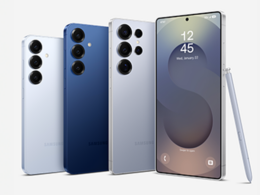There’s a lot to consider when you’re buying a new smartwatch. Beyond just telling time, modern smartwatches are packed with features that can simplify your daily life, from tracking fitness goals to managing notifications on the go. With so many options available, it’s important to focus on the features that best match your needs, whether it’s advanced health tracking, seamless phone integration, or a sleek design that complements your style. Below, you’ll find an in-depth exploration of these tips for investing in the right smartwatch.
Smartwatches vs fitness trackers
Make sure you’re actually looking for smartwatch instead of a fitness tracker. These two devices have different purposes and features.
- Fitness trackers only help you keep track of your health, but they do it well. They monitor your heart rate, your workout details, and other data. When you use a fitness tracker, you’re interacting with a single app that connects to an app on your phone.
- Smartwatches can also track your fitness info. But they can manage your text messages, forward your phone alerts, and run many other smartwatch apps, too. A smartwatch can even place calls if you choose one with that feature.
The smartwatch features you need
When considering how to pick a smartwatch, it’s important to balance your most important features—like advanced fitness tracking or a long battery life—with the look and feel. Is it easy to understand and use? Does it look nice on your wrist? Smartwatches have already come a long way from their bulky, blocky beginnings. But some pay more attention to appearances, while others focus on function. Here are some key features to weigh before picking the best smartwatch:
Phone compatibility
Your top concern is probably matching your smartwatch with your smartphone. You don’t always have to, but it helps. For example, if you have the latest Apple® iPhone®, you’ll be able to use all the features of an Apple Watch Series 10. If you own an Android device, you might choose a Tizen-based watch like the Samsung Gear S3 or Samsung Galaxy Watch Ultra, or a Wear OS by Google Smartwatch (formerly Android Wear).
Display type
The display type on a smartwatch affects both visibility and battery life. Smartwatches use either OLED (Organic Light-Emitting Diode) displays, or their subcategory, AMOLED (Active-Matrix Organic Light-Emitting Diode) displays. OLED displays offer bright colors and better contrast on the watch face but may reduce battery life.
In AMOLED, each pixel is a self-illuminating organic light-emitting diode. This creates a more energy-efficient, colorful, bright display and is becoming the more common choice for manufacturers. Because of the quality, they might also mean a more costly smartwatch. Note that since AMOLED is a category of the broader OLED display technology, the manufacturer may list OLED in their specs instead of AMOLED.
LCD displays, on the other hand, are a more inexpensive option. They’re easier on battery life but may not be as vibrant. Another option are monochromatic displays, which are great for battery life and outdoor visibility but lack the visual appeal of color displays.
Battery life
Battery life varies greatly depending on the smartwatch’s features. If you’re looking for a watch with long battery life, hybrid smartwatches, which have an analog face but digital features like messaging and health tracking, or those with simpler displays tend to last the longest. Some models can last weeks on a single charge, while an advanced smart watch series with OLED screens models may require more frequent charging.
Water resistance
If you plan to wear your smartwatch during workouts or outdoor activities, water resistance may be a feature you’re looking for. Most smartwatches are water-resistant, but only some can handle swimming or deep water immersion. For instance, the Apple Watch Ultra is built for underwater exploration, while other models, like the Fitbit Charge, are suitable for light water use.
Customization
Having the option to swap out watch bands or watch face designs and colors gives you the power of personalization. Some smartwatches use standard springs like traditional watches, while others have systems designed specifically for that watch.
Regardless of the model you choose, there are often many branded and off-brand options available across the internet. But make sure you research the quality before you buy to make sure you’re getting a band that will keep your smartwatch safe and secure on your wrist.
App selection
The number of apps available for your smartwatch can significantly enhance its usefulness. Watches like the Apple Watch models offer thousands of apps through their dedicated Watch App Store, while others, such as Fitbit Versa, have a more limited selection to focus on niches like health tracking. When choosing which smartwatch is best for you, consider what apps you’ll need, whether for productivity, fitness tracking, or smart home controls.
Charging method
Different smartwatches offer different charging methods. Wireless charging is common in high-end models like the Apple Watch series and Samsung Galaxy Watch. Simply place your watch on a charging station and you’re good to go. However, some fitness feature-focused models, like those from Garmin and Fitbit, still use proprietary chargers that you need to keep on hand.
Smartwatch applications to consider
So, why get a smartwatch? When it comes to using these features, smartwatches are designed to seamlessly integrate with your lifestyle. Below are some key applications you might want to consider when choosing the perfect smartwatch.
The workplace
Smartwatches can be great tools for boosting productivity and staying organized throughout your day, including at work. From managing notifications to using digital assistants, they provide multiple ways to enhance your workflow. Here are some of the top workplace-related features:
- Voice assistant integration: Use voice commands for hands-free tasks, such as scheduling meetings, sending messages, or conducting quick online searches.
- Email and messaging notifications: Stay on top of your communications by receiving email, text, and app notifications directly on your wrist.
- Calendar sync: Get reminders and manage your work schedule with calendar alerts, ensuring you never miss a meeting.
- Note-taking: Dictate quick notes and ideas on the go with voice recognition or dedicated note-taking apps.
- Fitness breaks: Many smartwatches include reminders to stand or move, helping you stay active during long work sessions.
Health & fitness
Today, even the most basic smartwatches offer basic metric trackers like heart rate sensors, but more advanced models provide in-depth fitness features for a variety of activities. Beyond tracking your workouts, these health tracking watches can monitor your overall well-being and performance. Health and fitness features may include:
- Workout activity, distance, and duration: Monitor your workout activities, including distance, steps, and duration of various exercises.
- Swim-tracking (waterproof IPx8 recommended): For swimmers, waterproof smartwatches (with IPx8 certification) track swim strokes, distance, and time spent in the water.
- Calories burned: Tracking calories burned throughout the day and during workouts can help you stay on top of your fitness goals.
- GPS tracking: Watches with GPS tracking enabled allow you to accurately log routes for running, biking, and other outdoor activities.
- Music streaming or storage: Enjoy music on the go, whether you stream or store playlists for offline listening during workouts.
- Sleep tracking: Monitor your sleep patterns with sleep tracking features, including light and deep sleep cycles, for a comprehensive view of your recovery and rest.
- Blood oxygen monitoring: Advanced models may offer SpO2 sensors that measure your blood oxygen levels, giving you additional insights into your overall health.
- Fall detection: Some smartwatches are equipped with fall detection sensors, which can automatically alert emergency contacts if a hard fall is registered. These devices are among the best fitness watch options for the elderly.
Do I need a smartwatch?
So, can a smartwatch replace your phone? Not without a bigger investment, and even then, not entirely. The top-of-the-line smartwatch series selection available includes high-speed data, so you can make and receive calls, browse online, and much more.
- Hands-free navigation
- Mobile payments
- Voice recognition
Plus, depending on your brand or operating system, you can probably download hundreds if not thousands of third-party smartwatch apps. Unfortunately, smartwatches aren’t digital cameras. Not yet.
Picking the right smartwatch with AT&T
In the end, how your smartwatch looks might help you make your decision. Do you want a premium smartwatch with an ultra-tech look… or one that looks like a traditional watch? You can change some watch faces with a tap or a swipe, choosing from dozens of colors and designs. Switch out your smartwatch band as well, because they offer traditional metal or leather bands, as well as the more casual silicone styles.
These features are must-haves when considering how to pick a smartwatch:
- Works with my phone
- Makes and receives calls
- Runs plenty of apps and games
- Tolerates swimming
- Supports voice recognition
- Offers GPS and hands-free navigation
- Looks like a classic watch
What does your list look like? Browse smartwatches and wearable devices at AT&T today.
This article is AT&T sponsored content, updated by Zoya Cochran, TechBuzz by AT&T and AT&T Business Insights blog editor and contributor.
It was originally written by a former AT&T employee. The postings on this site are my own and don’t necessarily represent the positions, strategies, or opinions of AT&T.





